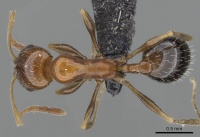Royidris pulchra
| Royidris pulchra | |
|---|---|

| |
| Scientific classification | |
| Kingdom: | Animalia |
| Phylum: | Arthropoda |
| Class: | Insecta |
| Order: | Hymenoptera |
| Family: | Formicidae |
| Subfamily: | Myrmicinae |
| Tribe: | Crematogastrini |
| Genus: | Royidris |
| Species group: | robertsoni |
| Species: | R. pulchra |
| Binomial name | |
| Royidris pulchra Bolton & Fisher, 2014 | |
The single type and only known specimen of this species was collected from tropical dry forest.
Identification
A member of the robertsoni species group. Bolton and Fisher (2014) - A member of the robertsoni group, pulchra, like Royidris pallida, combines characters of unsculptured head and lack of a metanotal groove within the group. Apart from the strikingly different colour of these two species, pulchra is larger than pallida, has a relatively longer scape, larger eye, and longer metafemur; it also has two pairs of petiolar setae, as opposed to one in pallida.
Keys including this Species
Distribution
Endemic to Madagascar.
Latitudinal Distribution Pattern
Latitudinal Range: -15.97111111° to -15.97111111°.
| North Temperate |
North Subtropical |
Tropical | South Subtropical |
South Temperate |
- Source: AntMaps
Distribution based on Regional Taxon Lists
Malagasy Region: Madagascar (type locality).
Distribution based on AntMaps
Distribution based on AntWeb specimens
Check data from AntWeb
Countries Occupied
| Number of countries occupied by this species based on AntWiki Regional Taxon Lists. In general, fewer countries occupied indicates a narrower range, while more countries indicates a more widespread species. |

|
Estimated Abundance
| Relative abundance based on number of AntMaps records per species (this species within the purple bar). Fewer records (to the left) indicates a less abundant/encountered species while more records (to the right) indicates more abundant/encountered species. |

|
Biology
Castes
Known only from the worker caste.
Nomenclature
The following information is derived from Barry Bolton's Online Catalogue of the Ants of the World.
- pulchra. Royidris pulchra Bolton & Fisher, 2014: 62, figs. 69-71 (w.) MADAGASCAR.
- Type-material: holotype worker.
- Type-locality: Madagascar: Mahajanga, Forêt Ambohimanga, 26.1 km. 314° Mampikony, 15°57.76’S, 47°26.29’E, 250 m., 13-15.xii.2004, BLF 11757, CASENT0052581, tropical dry forest (B.L. Fisher).
- Type-depository: CASC.
- Distribution: Madagascar.
Unless otherwise noted the text for the remainder of this section is reported from the publication that includes the original description.
Description
Worker
Holotype. TL 3.0, HL 0.70, HW 0.59, CI 84, SL 0.66, SI 112, PW 0.42, WL 0.87.
Antennal club 3-segmented. Mandible longitudinally costulate. Scapes of relatively moderate length (SI 112); when laid straight back in full-face view the apex of the scape exceeds the posterior margin of the head. With head in full-face view the eyes very close to the midlength of the side of the head capsule. EL 0.19 (EL/HW 0.32). Dorsum of head from level of eyes to posterior margin smooth and polished, with scattered minute punctulae. Promesonotum in profile convex and swollen, domed, the mesonotum posteriorly descends steeply to the commencement of the propodeum, the metanotal groove is absent. In absolute profile the propodeal dorsum, from its junction with the mesonotum, rises slightly posteriorly to about the level of the propodeal spiracle, behind which it descends slightly to the bluntly rounded posterior angle; the declivity is straight and almost vertical. The whole propodeal dorsum is strongly depressed with respect to the highest point of the promesonotum, which is on a considerably higher level. Pronotum with a seta at the right humeral angle but not at the left; without other pronotal setae in the holotype but it is possible that a more posterior pair was lost by abrasion. Mesonotum with 2 pairs of short setae; dorsum of propodeum lacks setae. Pronotal dorsum smooth and shining; propodeal dorsum superficially reticulate-punctulate, more strongly sculptured than the pronotum. Lower side of pronotum weakly, superficially reticulate-punctulate to reticulate-shagreenate, this sculpture fading out on the upper half of the side. Mesopleuron reticulate-punctulate, metapleuron similarly sculptured and also with some weak longitudinal costulae. Metafemur relatively long and slender, MfL 0.78 (MfL/HW 1.32, MfL/MfH 6.00). Petiole with a pair of setae at the apex of the node, and with another pair on its posterior face; postpetiole with setae dorsally and posteriorly; first gastral tergite with numerous suberect setae that are shorter than the maximum vertical diameter of the eye. Postpetiole relatively narrow in dorsal view, maximum width 0.22 (0.37 × HW). Dorsum of postpetiole and first gastral tergite unsculptured. Colour of head, mesosoma, petiole, postpetiole and legs medium brown, the gaster black.
Type Material
Holotype worker, Madagasacar: Mahajanga, Forêt Ambohimanga, 26.1 km. 314° Mampikony, 250 m., 15°57.76’S, 47°26.29’E, 13–15.xii.2004, BLF 11757, CASENT0052581, tropical dry forest (B.L. Fisher) (California Academy of Sciences).
References
- Bolton, B. & Fisher, B.L. 2014. The Madagascan endemic myrmicine ants related to Eutetramorium (Hymenoptera: Formicidae): taxonomy of the genera Eutetramorium Emery, Malagidris nom. n., Myrmisaraka gen. n., Royidris gen. n., and Vitsika gen. n. Zootaxa 3791:1–99. doi:10.11646/zootaxa.3791.1.1

